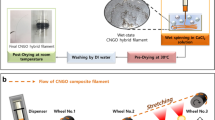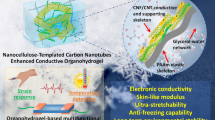Abstract
Multifunctional fibers have attracted widespread attention due to applications in flexible smart wearable devices. However, simultaneously obtaining a strong and functional woven fiber is still a great challenge owing to the conflict between the properties mentioned above. Herein, mechanically strong and highly conductive cellulose/carbon nanotube (CNT) composite fibers were spun using an aqueous alkaline/urea solution. The microstructure as well as physical properties of the resulting fibers were characterized via scanning electron microscopy, infrared spectroscopy, mechanical and electrical measurement. We demonstrated that carboxylic CNTs can be well dispersed in alkali/urea aqueous systems which also dissolved cellulose well. The subsequent wet spinning process aligned the CNTs and cellulose molecules inside the regenerated composite fiber well, enhancing the interaction between these two components and endowing the composite fiber having a 20% CNT loading with an excellent mechanical strength of 185 MPa. Benefiting from the formation of conductive paths, the composite fiber with the diameter of about 50 μm possessed an electrical conductivity value in the range of 64–1274 S/m for 5–20 wt% CNT loading. This excellent mechanical strength and high electrical conductivity enable the composite fiber to exhibit a great potential in joule heating; the heating temperature of cellulose/CNT-20 fiber reached more than 55 °C within 15 s at 9 V. In addition, the multifunctional filaments are further manufactured as a water sensor to measure humidity. This work provides a potential material that can be applied in the fields of wearable electronics and smart flexible fabrics.
Graphic abstract








Similar content being viewed by others
References
Blanchard NP, Hatton RA, Silva SRP (2007) Tuning the work function of surface oxidised multi-wall carbon nanotubes via cation exchange. Chem Phys Lett 434(1–3):92–95. https://doi.org/10.1016/j.cplett.2006.11.100
Bober P, Liu J, Mikkonen KS, Ihalainen P, Pesonen M, Plumed-Ferrer C, Wright AV, Lindfors T, Xu CL, Latonen RM (2014) Biocomposites of nanofibrillated cellulose, polypyrrole, and silver nanoparticles with electroconductive and antimicrobial properties. Biomacromol 15(10):3655–3663. https://doi.org/10.1021/bm500939x
Cai J, Zhang LN, Chang CY, Cheng GZ, Chen XM, Chu B (2007) Hydrogen-bond-induced inclusion complex in aqueous cellulose/LiOH/urea solution at low temperature. ChemPhysChem 8(10):1572–1579. https://doi.org/10.1002/cphc.200700229
Cai J, Zhang L, Liu SL, Liu YT, Xu XJ, Chen XM, Chu B, Guo XL, Xu J, Cheng H, Han CC, Kuga S (2008) Dynamic self-assembly induced rapid dissolution of cellulose at low temperatures. Macromolecules 41(23):9345–9351. https://doi.org/10.1021/ma801110g
Carrasco PM, Montes S, Garcia I, Borghei M, Jiang H, Odriozola I, Cabanero G, Ruiz V (2014) High-concentration aqueous dispersions of graphene produced by exfoliation of graphite using cellulose nanocrystals. Carbon 70:157–163. https://doi.org/10.1016/j.carbon.2013.12.086
Chen Y, Potschke P, Pionteck J, Voit B, Qi HS (2018) Smart cellulose/graphene composites fabricated by in situ chemical reduction of graphene oxide for multiple sensing applications. J Mater Chem A 6(17):7777–7785. https://doi.org/10.1039/C8TA00618K
Cho SY, Yu H, Choi J, Kang H, Park S, Jang JS, Hong HJ, Kim ID, Lee SK, Jeong HS, Jung HT (2019) Continuous meter-scale synthesis of weavable tunicate cellulose/carbon nanotube fibers for high-performance wearable sensors. ACS Nano 13(8):9332–9341
Dichiara AB, Song A, Goodman SM, He D, Bai J (2017) Smart papers comprising carbon nanotubes and cellulose microfibers for multifunctional sensing applications. J Mater Chem A 5(38):20161–20169. https://doi.org/10.1039/C7TA04329E
Ferreira ES, Silva DS, Burgo TAL, Batista BC, Galembeck F (2017) Graphite exfoliation in cellulose solutions. Nanoscale 9(29):10219–10226. https://doi.org/10.1039/C7NR02365K
Hamedi MM, Hajian A, Fall AB, Hakansson K, Salajkova M, Lundell F, Wagberg L, Berglund LA (2014) Highly conducting, strong nanocomposites based on nanocellulose-assisted aqueous dispersions of single-wall carbon nanotubes. ACS Nano 8(3):2467–2476. https://doi.org/10.1021/nn4060368
Hardelin L, Hagstrom B (2015) Wet spun fibers from solutions of cellulose in an ionic liquid with suspended carbon nanoparticles. J Appl Polym Sci 132(6):41417. https://doi.org/10.1002/APP.41417
Huang HD, Liu CY, Zhang LQ, Zhong GJ, Li ZM (2015) Simultaneous reinforcement and toughening of carbon nanotube/cellulose conductive nanocomposite films by interfacial hydrogen bonding. ACS Sustain Chem Eng 3(2):317–324. https://doi.org/10.1021/sc500681v
Jiang ZM, Chen DN, Yu YQ, Miao JJ, Liu Y, Zhang LP (2017a) Composite fibers prepared from multi-walled carbon nanotubes/cellulose dispersed/dissolved in ammonium/dimethyl sulfoxide mixed solvent. RSC Adv 7(4):2186–2192. https://doi.org/10.1039/C6RA25318K
Jiang ZW, Fang Y, Xiang JF, Ma YP, Lu A, Kang HL, Huang Y, Guo HX, Liu RG, Zhang LN (2014) Intermolecular interactions and 3D structure in cellulose-NaOH-urea aqueous system. J Phys Chem B 118(34):10250–10257. https://doi.org/10.1021/jp501408e
Jiang ZW, Fang Y, Ma YP, Liu M, Liu RG, Guo HX, Lu A, Zhang L (2017b) Dissolution and metastable solution of cellulose in NaOH/thiourea at 8°C for construction of nanofibers. J Phys Chem B 121(8):1793–1801. https://doi.org/10.1021/acs.jpcb.6b10829
Klemm D, Heublein B, Fink HP, Bohn A (2005) Cellulose: fascinating biopolymer and sustainable raw material. Angew Chem Int Edit 44(22):3358–3393. https://doi.org/10.1002/chin.200536238
Koga H, Saito T, Kitaoka T, Nogi M, Suganuma K, Isogai A (2013) Transparent, conductive, and printable composites consisting of TEMPO-oxidized nanocellulose and carbon nanotube. Biomacromol 14(4):1160–1165. https://doi.org/10.1021/bm400075f
Kontturi E, Laaksonen P, Linder MB, Nonappa GAH, Rojas OJ, Ikkala O (2018) Advanced materials through assembly of nanocelluloses. Adv Mater 30(24):1703779. https://doi.org/10.1002/adma.201703779
Lee TW, Han M, Lee SE, Jeong YG (2016a) Electrically conductive and strong cellulose-based composite fibers reinforced with multiwalled carbon nanotube containing multiple hydrogen bonding moiety. Compos Sci Technol 123:57–64. https://doi.org/10.1016/j.compscitech.2015.12.006
Lee TW, Lee SE, Jeong YG (2016b) Carbon nanotube/cellulose papers with high performance in electric heating and electromagnetic interference shielding. Compos Sci Technol 131:77–87. https://doi.org/10.1016/j.compscitech.2016.06.003
Li YY, Zhu HL, Wang YB, Ray U, Zhu SZ, Dai JQ, Chen CJ, Fu K, Jang SH, Henderson D, Li T, Hu LB (2017) Cellulose-nanofiber-enabled 3D printing of a carbon-nanotube microfiber network. Small Methods 1(10):1700222. https://doi.org/10.1002/smtd.201700222
Ma JH, Wang P, Dong L, Ruan YB, Lu HB (2019) Highly conductive, mechanically strong graphene monolith assembled by three-dimensional printing of large graphene oxide. J Colloid Interf Sci 534:12–19. https://doi.org/10.1016/j.jcis.2018.08.096
Mahmoudian S, Sazegar MR, Afshari N, Wahit MU (2017) Graphene reinforced regenerated cellulose nanocomposite fibers prepared by lyocell process. Polym Compos 38:81–88. https://doi.org/10.1002/pc.23864
Qi HS, Liu JW, Gao SL, Mader E (2013) Multifunctional films composed of carbon nanotubes and cellulose regenerated from alkaline-urea solution. J Mater Chem A 1(6):2161–2168. https://doi.org/10.1039/C2TA00882C
Qi H, Liu J, Deng Y, Gao S, Mäder E (2014) Cellulose fibres with carbon nanotube networks for water sensing. J Mater Chem A 2(15):5541–5547. https://doi.org/10.1039/C3TA14820C
Qi HS, Schulz B, Vad T, Liu JW, Mader E, Seide G, Gries T (2015) Novel carbon nanotube/cellulose composite fibers as multifunctional materials. ACS Appl Mater Inter 7(40):22404–22412. https://doi.org/10.1021/acsami.5b06229
Shi XW, Hu YL, Fu FY, Zhou JP, Wang YX, Chen LY, Zhang HM, Li J, Wang XH, Zhang LN (2014) Construction of PANI-cellulose composite fibers with good antistatic properties. J Mater Chem A 2(21):7669–7673. https://doi.org/10.1039/C4TA01149J
Siqueira G, Kokkinis D, Libanori R, Hausmann MK, Gladman AS, Neels A, Tingaut P, Zimmermann T, Lewis JA, Studart AR (2017) Cellulose nanocrystal inks for 3D printing of textured cellular architectures. Adv Funct Mater 27(12):1604619. https://doi.org/10.1002/adfm.201604619
Sun HB, Miao JJ, Yu YQ, Zhang LP (2015) Dissolution of cellulose with a novel solvent and formation of regenerated cellulose fiber. Appl Phys A-Mater 119(2):539–546. https://doi.org/10.1007/s00339-015-8986-6
Wan ZM, Chen CC, Meng TT, Mojtaba M, Teng YC, Feng Q, Li DG (2019) Multifunctional wet-spun filaments through robust nanocellulose networks wrapping to single-walled carbon nanotubes. ACS Appl Mater Inter 11(45):42808–42817. https://doi.org/10.1021/acsami.9b15153
Wang JF, Huang S, Lu X, Xu ZG, Zhao Y, Li JL, Wang XG (2017) Wet-spinning of highly conductive nanocellulose-silver fibers. J Mater Chem C 37(5):9673–9679. https://doi.org/10.1039/C7TC03217J
Wang QW, Zhang HB, Liu J, Zhao S, Xie X, Liu L, Yang R, Koratkar N, Yu ZZ (2019) Multifunctional and water-resistant MXene-decorated polyester textiles with outstanding electromagnetic interference shielding and joule heating performances. Adv Funct Mater 29(7):1806819. https://doi.org/10.1002/adfm.201806819
Wepasnick KA, Smith BA, Schrote KE, Wilson HK, Diegelmann SR, Fairbrother DH (2011) Surface and structural characterization of multi-walled carbon nanotubes following different oxidative treatments. Carbon 49(1):24–36. https://doi.org/10.1016/j.carbon.2010.08.034
Yan Z, Chen S, Wang H, Wang B, Jiang J (2008) Biosynthesis of bacterial cellulose/multi-walled carbon nanotubes in agitated culture. Carbohyd Polym 74(3):659–665. https://doi.org/10.1016/j.carbpol.2008.04.028
Ye DD, Lei XJ, Li T, Cheng QY, Chang CY, Hu LB, Zhang LN (2019) Ultrahigh tough, super clear, and highly anisotropic nanofiber-structured regenerated cellulose films. ACS Nano 13(4):4843–4853. https://doi.org/10.1021/acsnano.9b02081
Zhang HR, Sun XW, Heng ZG, Chen Y, Zou HW, Liang M (2018) Robust and flexible cellulose nanofiber/multiwalled carbon nanotube film for high-performance electromagnetic interference shielding. Ind Eng Chem Res 57(50):17152–17160. https://doi.org/10.1021/acs.iecr.8b04573
Zhang H, Wang ZG, Zhang ZN, Wu J, Zhang J, He HS (2007) Regenerated-cellulose/multiwalled-carbon-nanotube composite fibers with enhanced mechanical properties prepared with the ionic liquid 1-allyl-3-methylimidazolium chloride. Adv Mater 19(5):698–704. https://doi.org/10.1002/adma.200600442
Zhao X, Wang LY, Tang CY, Zha XJ, Liu Y, Su BH, Ke K, Bao RY, Yang MB, Yang W (2020) Smart Ti3C2Tx MXene fabric with fast humidity response and joule heating for healthcare and medical therapy applications. ACS Nano 14(7):8793–8805. https://doi.org/10.1021/acsnano.0c03391
Zhu KK, Qiu CB, Lu A, Luo LB, Guo JH, Cong HJ, Chen F, Liu XY, Zhang X, Wang H, Cai J, Fu Q, Zhang LN (2018) Mechanically strong multifilament fibers spun from cellulose solution via inducing formation of nanofibers. ACS Sustain Chem Eng 6(4):5314–5321. https://doi.org/10.1021/acssuschemeng.8b00039
Acknowledgments
This study was funded by National Natural Science Foundation of China (51903198), Scientific Research Program Funded by Shaanxi Provincial Education Department (20JY025), Innovation Capability Support Program of Shaanxi (2020TD-010), Open Research Project by State Key Laboratory of Polymer Molecular Engineering of Fudan University (K2020-25), Xi’an Polytechnic University-Shaoxing Keqiao West-Tex Textile Industry Innovative Institute Collaborative innovation project (19KQZD13).
Author information
Authors and Affiliations
Contributions
JM, CW and YW conceived the idea and designed the experiments. HP and PH carry out the experiment as well as the test characterization. QZ and SP discussed the results and commented on the manuscript. All the authors have approved the final version of the manuscript.
Corresponding author
Ethics declarations
Conflict of interest
The authors declare that they have no known competing financial interest or personal relationships that could have appeared to influence the work reported in this paper.
Ethical approval
All procedures performed in studies involving human participants were in accordance with the ethical standards of the institutional and/or national research committee and with the 1964 Helsinki declaration and its later amendments or comparable ethical standards.
Informed consent
Informed consent was obtained from all individual participants included in the study.
Additional information
Publisher's Note
Springer Nature remains neutral with regard to jurisdictional claims in published maps and institutional affiliations.
Rights and permissions
About this article
Cite this article
Ma, J., Pu, H., He, P. et al. Robust cellulose-carbon nanotube conductive fibers for electrical heating and humidity sensing. Cellulose 28, 7877–7891 (2021). https://doi.org/10.1007/s10570-021-04026-y
Received:
Accepted:
Published:
Issue Date:
DOI: https://doi.org/10.1007/s10570-021-04026-y




